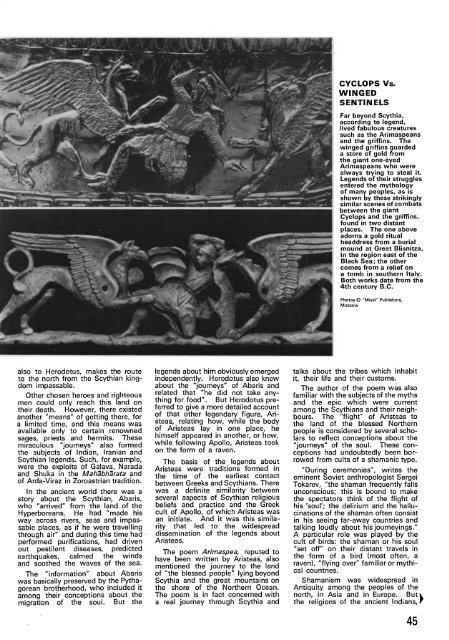The Scythians: nomad goldsmiths of the open steppes; The ...
The Scythians: nomad goldsmiths of the open steppes; The ...
The Scythians: nomad goldsmiths of the open steppes; The ...
Create successful ePaper yourself
Turn your PDF publications into a flip-book with our unique Google optimized e-Paper software.
also to Herodotus, makes <strong>the</strong> route<br />
to <strong>the</strong> north from <strong>the</strong> Scythian king¬<br />
dom impassable.<br />
O<strong>the</strong>r chosen heroes and righteous<br />
men could only reach this land on<br />
<strong>the</strong>ir death. However, <strong>the</strong>re existed<br />
ano<strong>the</strong>r "means" <strong>of</strong> getting <strong>the</strong>re, for<br />
a limited time, and this means was<br />
available only to certain renowned<br />
sages, priests and hermits. <strong>The</strong>se<br />
miraculous "journeys" also formed<br />
<strong>the</strong> subjects <strong>of</strong> Indian, Iranian and<br />
Scythian legends. Such, for example,<br />
were <strong>the</strong> exploits <strong>of</strong> Galava, Narada<br />
and Shuka in <strong>the</strong> Mahabharata and<br />
<strong>of</strong> Arda-Viraz in Zoroastrian tradition.<br />
In <strong>the</strong> ancient world <strong>the</strong>re was a<br />
story about <strong>the</strong> Scythian, Abaris,<br />
who "arrived" from <strong>the</strong> land <strong>of</strong> <strong>the</strong><br />
Hyperboreans. He had "made his<br />
way across rivers, seas and impas¬<br />
sable places, as if he were travelling<br />
through air" and during this time had<br />
performed purifications, had driven<br />
out pestilent diseases, predicted<br />
earthquakes, calmed <strong>the</strong> winds<br />
and soo<strong>the</strong>d <strong>the</strong> waves <strong>of</strong> <strong>the</strong> sea.<br />
<strong>The</strong> "information" about Abaris<br />
was basically preserved by <strong>the</strong> Pytha¬<br />
gorean bro<strong>the</strong>rhood, who included it<br />
among <strong>the</strong>ir conceptions about <strong>the</strong><br />
migration <strong>of</strong> <strong>the</strong> soul. But <strong>the</strong><br />
legends about him obviously emerged<br />
independently. Herodotus also knew<br />
about <strong>the</strong> "journeys" <strong>of</strong> Abaris and<br />
related that "he did not take any¬<br />
thing for food". But Herodotus pre¬<br />
ferred to give a more detailed account<br />
<strong>of</strong> that o<strong>the</strong>r legendary figure, Aristeas,<br />
relating how, while <strong>the</strong> body<br />
<strong>of</strong> Aristeas lay in one place, he<br />
himself appeared in ano<strong>the</strong>r, or how,<br />
while following Apollo, Aristeas took<br />
on <strong>the</strong> form <strong>of</strong> a raven.<br />
<strong>The</strong> basis <strong>of</strong> <strong>the</strong> legends about<br />
Aristeas were traditions formed in<br />
<strong>the</strong> time <strong>of</strong> <strong>the</strong> earliest contact<br />
between Greeks and <strong>Scythians</strong>. <strong>The</strong>re<br />
was a definite similarity between<br />
several aspects <strong>of</strong> Scythian religious<br />
beliefs and practice and <strong>the</strong> Greek<br />
cult <strong>of</strong> Apollo, <strong>of</strong> which Aristeas was<br />
an initiate. And it was this simila¬<br />
rity that led to <strong>the</strong> widespread<br />
dissemination <strong>of</strong> <strong>the</strong> legends about<br />
Aristeas.<br />
<strong>The</strong> poem Arimaspea, reputed to<br />
have been written by Aristeas, also<br />
mentioned <strong>the</strong> journey to <strong>the</strong> land<br />
<strong>of</strong> "<strong>the</strong> blessed people" lying beyond<br />
Scythia and <strong>the</strong> great mountains on<br />
<strong>the</strong> shore <strong>of</strong> <strong>the</strong> Nor<strong>the</strong>rn Ocean.<br />
<strong>The</strong> poem is in fact concerned with<br />
a real journey through Scythia and<br />
CYCLOPS Vs.<br />
WINGED<br />
SENTINELS<br />
Far beyond Scythia,<br />
according to legend,<br />
lived fabulous creatures<br />
such as <strong>the</strong> Arimaspeans<br />
and <strong>the</strong> griffins. <strong>The</strong><br />
winged griffins guarded<br />
a store <strong>of</strong> gold from<br />
<strong>the</strong> giant one-eyed<br />
Arimaspeans who were<br />
always trying to steal it.<br />
Legends <strong>of</strong> <strong>the</strong>ir struggles<br />
entered <strong>the</strong> mythology<br />
<strong>of</strong> many peoples, as is<br />
shown by <strong>the</strong>se strikingly<br />
similar scenes <strong>of</strong> combats<br />
between <strong>the</strong> giant<br />
Cyclops and <strong>the</strong> griffins,<br />
found in two distant<br />
places. <strong>The</strong> one above<br />
adorns a gold ritual<br />
headdress from a burial<br />
mound at Great Blisnitza,<br />
in <strong>the</strong> region east <strong>of</strong> <strong>the</strong><br />
Black Sea; <strong>the</strong> o<strong>the</strong>r<br />
comes from a relief on<br />
a tomb in sou<strong>the</strong>rn Italy.<br />
Both works date from <strong>the</strong><br />
4th century B.C.<br />
Photos © "Miysl" Publishers,<br />
Moscow<br />
talks about <strong>the</strong> tribes which inhabit<br />
it, <strong>the</strong>ir life and <strong>the</strong>ir customs.<br />
<strong>The</strong> author <strong>of</strong> <strong>the</strong> poem was also<br />
familiar with <strong>the</strong> subjects <strong>of</strong> <strong>the</strong> myths<br />
and <strong>the</strong> epic which were current<br />
among <strong>the</strong> <strong>Scythians</strong> and <strong>the</strong>ir neigh¬<br />
bours. <strong>The</strong> "flight" <strong>of</strong> Aristeas to<br />
<strong>the</strong> land <strong>of</strong> <strong>the</strong> blessed Nor<strong>the</strong>rn<br />
people is considered by several scho¬<br />
lars to reflect conceptions about <strong>the</strong><br />
"journeys" <strong>of</strong> <strong>the</strong> soul. <strong>The</strong>se con¬<br />
ceptions had undoubtedly been bor¬<br />
rowed from cults <strong>of</strong> a shamanic type.<br />
"During ceremonies", writes <strong>the</strong><br />
eminent Soviet anthropologist Sergei<br />
Tokarev, "<strong>the</strong> shaman frequently falls<br />
unconscious; this is bound to make<br />
<strong>the</strong> spectators think <strong>of</strong> <strong>the</strong> flight <strong>of</strong><br />
his 'soul'; <strong>the</strong> delirium and <strong>the</strong> hallu¬<br />
cinations <strong>of</strong> <strong>the</strong> shaman <strong>of</strong>ten consist<br />
in his seeing far-away countries and<br />
talking loudly about hisjourneyings."<br />
A particular role was played by <strong>the</strong><br />
cult <strong>of</strong> birds: <strong>the</strong> shaman or his soul<br />
"set <strong>of</strong>f" on <strong>the</strong>ir distant travels in<br />
<strong>the</strong> form <strong>of</strong> a bird (most <strong>of</strong>ten, a<br />
raven), "flying over" familiar or mythi¬<br />
cal countries.<br />
Shamanism was widespread in<br />
Antiquity among <strong>the</strong> peoples <strong>of</strong> <strong>the</strong><br />
north, in Asia and in Europe. Butw<br />
<strong>the</strong> religions <strong>of</strong> <strong>the</strong> ancient Indians, t<br />
45

















